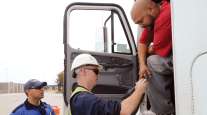Senior Reporter
ATA, European Officials Address Driver Shortage

[Stay on top of transportation news: Get TTNews in your inbox.]
Leaders from American Trucking Associations during an overseas visit with European policymakers discussed the many challenges they share, including a driver shortage that is being exacerbated for international fleets by the war in Ukraine.
“This is a global issue, certainly in Europe.” said ATA Chief Economist Bob Costello, who joined ATA President Chris Spear and Chairman Dan Van Alstine for a December trip to Europe for meetings with members of the International Road Transport Union (IRU). “Labor has become a very hot topic here in the last few years. But it’s certainly more unique to the occupation than it is to a geographic region; this idea that the truck driver shortage is somehow unique to [the U.S.] couldn’t be more wrong.”
Across the 27 European Union nations a shortage estimated at more than 100,000 drivers has worsened as thousands of Ukrainian men — some already professional truck drivers, others considering it as a career option — joined the country’s army to fight Russian military forces that invaded 11 months ago.
Spear noted that EU officials are strongly considering a proposal similar to a federal U.S. program to train younger drivers — in the U.S., those under the age of 21 — to become professional truck drivers.
Global #DriverShortages:
What is the situation?
What is being done?
What can be done?#YearInReviewhttps://t.co/Hfxqi0O9WW — IRU (@the_IRU) January 3, 2023
Recruitment of more women could also help, Costello noted; while the U.S. trucking industry has increased its population of female drivers to more than 7%, in Europe just 3% of drivers are women.
The trip was Van Alstine’s first European trip as ATA chairman, and it featured a visit to a DAF truck manufacturing plant in Eindhoven, Netherlands, where design features focused on drivers were showcased.

Dan Van Alstine (from left), Chris Spear, Raluca Marian of IRU, Bob Costello and Marc Billiet of IRU. (ATA)
“They’re getting feedback from the fleets that they need to have a cab that has attractive ergonomics for the driver, that there’s amenities for the driver in cab,” he said. “They’ve had to pivot over the last couple of years, as they’re getting their customers’ input that we have to create the cab of a truck that a driver wants to be in.”
A lack of safe truck parking is another shared challenge, and one that may be more daunting for European fleets, Costello said. “Drivers feel quite unsafe in some of the places where there’s designated truck parking,” he said.
Spear noted that workforce issues were just one area where ATA and IRU members focused on solving common goals. Also top-of-mind, he said, were environmental issues.
“We spent a lot of time on energy and environmental policy,” Spear said. “We’re very interested in benchmarking where Europe is, particularly compared to the U.S. — where are we ahead or we’re behind, who’s leading or who is following.”

ATA President Chris Spear checks out a DAF truck. (ATA)
The three also discussed with IRU leaders aggressive, mid-decade timelines that EU member nations are targeting to reach net-zero emissions. Spear said while ATA supports long-term goals for reducing carbon output from trucks, it believes the EU timelines and those under consideration in the U.S. by the California Air Resources Board are overly optimistic.
“We have some differences at the federal level with Europe on the timeline,” Spear said. “Their goals are definitely just as aggressive as California’s, if not more. Our [original equipment manufacturers] have made it very clear that those dates and targets being proposed by CARB are unachievable. The technology simply does not exist. There is a concerted effort by this industry in the U.S. to meet a better environmental objective that serves us all. But we need to do it realistically. And having that discussion really came to light when we were in Geneva with the ILO.”
The International Labour Organization is a United Nations agency whose mandate is to advance social and economic justice by setting international labor standards.
Van Alstine added, “We want to be very much involved in finding a path, but doing it on a realistic timeline and doing it with acknowledging the trade-offs that come with this.”
Want more news? Listen to today's daily briefing below or go here for more info:




